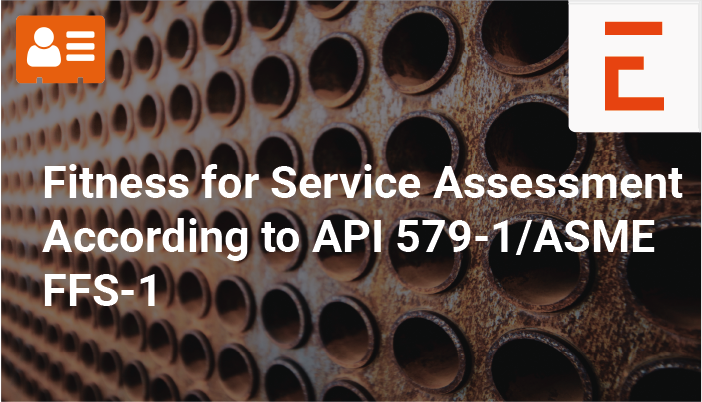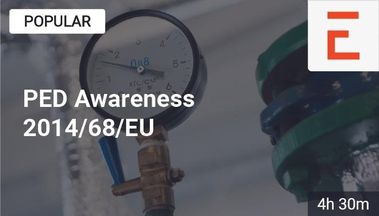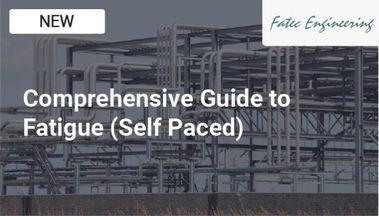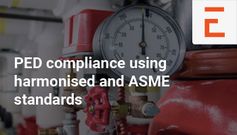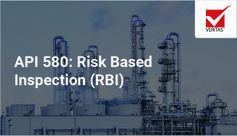Fitness for Service Assessment According to API 579-1/ ASME FFS-1
Join the Program
Virtual or Classroom
Registration deadline: 15 July 2024
26hr Live Sessions
Custom Scheduling
Shervin Maleki
INCO4501
Format:
Instructor-led
Join the Program
To register multiple team-members at once, use the link below.
Need a dedicated version of this program for your team? Please contact us.
"Dates and Payments will be arranged with you after the registration deadline. Register today!"
Course Objective
“Discover the tools and methodologies of API 579-1/ASME FFS-1 to evaluate, assess, and ensure the structural integrity of aging or damaged equipment, empowering you to extend asset lifespan and maximise operational reliability.”
Private course for team
Custom scheduling
Industry Expert
On-site or virtual
1-year access
to course material
PDH Hours qualified course
Read more here
About the course
In-Company
Live sessions
26hr Content
Registration deadline
15 July 2024
English
INCO4501
Fitness for Service (FFS) assessment, particularly guided by API 579-1/ASME FFS-1, has emerged as a crucial framework in the realm of structural integrity management. In today's industrial landscape, where aging equipment and infrastructure pose significant challenges, mastering API 579-1/ASME FFS-1 becomes imperative.
This course delves into the core principles and methodologies of API 579-1/ASME FFS-1, empowering engineers, inspectors, and asset integrity professionals to evaluate, analyse, and make informed decisions regarding the fitness of aging or damaged equipment. As equipment reaches different stages of its service life, understanding how to effectively assess and address flaws or damages becomes pivotal. This course equips participants with the knowledge and tools needed to safeguard equipment reliability, minimize downtime, optimize maintenance strategies, and ensure operational safety. By navigating through practical case studies and real-world scenarios, attendees gain actionable insights to address critical challenges and enhance the lifespan and performance of industrial assets.
This comprehensive course offers a deep dive into the essential facets of Fitness for Service (FFS) assessment aligned with the API 579-1/ASME FFS-1 standards. Beginning with an exploration of FFS fundamentals, participants embark on a journey through crucial topics such as stress analysis, damage mechanisms identification, assessment techniques, and structural integrity evaluation methodologies prescribed by API 579-1/ASME FFS-1. Delving into practical case studies and hands-on exercises, attendees gain proficiency in flaw assessment, corrosion evaluation, fracture assessment, and the intricacies of remaining life estimation.
The course consists of 26 hours of live sessions with the instructor. All training content is provided through your EngineeringTrainer account. After the course you maintain 1-year unlimited access to the course, including any new course material. This allows you to perform modules again should you need to refresh your knowledge.
Meet your instructor
Structural Integrity Consultant
Structural Integrity Assessment, Mechanical Behaviour Analysis
Program & Details
An introduction to FFS
Real case scenarios
FFS common codes and standards
Scope and structure of API 579-1/ASME FFS-1
Three levels of assessment
Data and information required
Important concepts: RSF
Basic Concepts
Stress in Pressure Equipment
ASME B&PV design concept
Allowable Stress
Primary and Secondary Stresses
Residual Stress
Finite Element Analysis
Strain Measurement
Work Examples
Failure modes
Flaw characterisation
Weld morphology
Pre-service flaws
In-service damage mechanisms
Work Example
Introduction to inspection techniques
Inspection effectiveness
Conditional probability
Work Examples
Damage Identification
Real-life case study
Charpy Ductile to Brittle Transition Curves
Minimum Allowable Temperature (MAT) and Critical Exposure Temperature (CET)
Part 3 Assessment Techniques and Acceptance Criteria
Work Example
Damage Identification
Types of pressure equipment based on ASME B&PV codes
Part 4 Assessment Techniques and Acceptance Criteria
Work Example
Damage Identification
Critical thickness Profile (CTP)
Part 4 Assessment Techniques and Acceptance Criteria for Local Metal Loss
Part 5 Assessment Techniques and Acceptance Criteria for Local Metal Loss
Work Examples
Damage Identification
Part 6 Assessment Techniques and Acceptance Criteria
Work Example
Damage Identification
Fundamentals of Hydrogen damage
Part 7 Assessment Techniques and Acceptance Criteria
Damage Identification
Part 8 Assessment Techniques and Acceptance Criteria
Damage Identification
Real life case study
Fundamentals of Fracture Mechanics
Fracture Toughness
Failure Assessment Diagram (FAD)
Part 9 Assessment Techniques and Acceptance Criteria
Work Examples
Damage Identification
Real-life case study
Fundamentals of high temperature material behaviour
Larson-Miller Parameter
Part 10 Assessment Techniques and Acceptance Criteria
Work Example
Damage Identification
Part 11 Assessment Techniques and Acceptance Criteria
Work Example
Damage Identification
Part 12 Assessment Techniques and Acceptance Criteria
Work Example
Damage Identification
Part 13 Assessment Techniques and Acceptance Criteria
Work Example
Damage Identification
Real-life case study
Fundamental of fatigue damage
Cycle counting
S-N curves
Fatigue Crack Growth and Paris Power Law
Part 14 Assessment Techniques and Acceptance Criteria
Work Examples
Results
After this course, you...
can recognise and categorise various degradation mechanisms impacting equipment integrity
understand the methodologies and guidelines outlined by API 579-1/ASME FFS-1 for assessing equipment fitness for service
have mastered techniques for flaw assessment, including crack evaluation, corrosion and pitting assessment, and flaw characterisation
understand the fundamentals of failure including plastic collapse, fracture failure, fatigue damage and high-temperature component life assessment
know how to perform a Brittle Fracture Analysis: can analyse the susceptibility to brittle fracture and implement mitigation strategies
be able to use the industry standard techniques for estimating remaining life and predicting equipment reliability
know how to navigate through the intricacies of Level 1 and 2 assessments as per API 579-1/ASME FFS-1 guidelines
be able to develop effective mitigation plans and decision-making based on FFS evaluations and their outcomes
have engaged with practical case studies and scenarios for hands-on application of API 579-1/ASME FFS-1 principles
Who should attend this course
Engineers (Mechanical, Structural, or Materials): Seeking expertise in assessing equipment integrity and evaluating fitness for continued service.
Inspection and Integrity Professionals: Involved in asset integrity management, inspection planning, and structural assessment.
Maintenance and Reliability Engineers: Focused on optimizing maintenance strategies and ensuring equipment reliability.
Asset Managers and Operations Personnel: Responsible for ensuring operational safety and efficiency of industrial equipment.
Quality Assurance/Quality Control (QA/QC) Professionals: Interested in enhancing quality assessment methods and reliability evaluations.
Prerequisites:
There are no specific prerequisites for this course. Having a foundational understanding or appreciation of pressure equipment could aid participants in grasping concepts more effectively during the course.
Level: Intermediate
This course consists of instructor-led live sessions which consist of presentations, demonstrations, discussions and worked cases. During each session, participants can ask questions to the instructor (through the chat or microphone) which will be answered in the session.
Access to the course
After signing up for the course, EngineeringTrainer will be in touch shortly after the Registration Deadline to agree a training schedule that is possible for the participants and instructor. Payment will also be arranged at this stage after the Registration Deadline.
Once the training schedule is agreed, you will find the course welcome chapter and instructions on how to join the live sessions in your EngineeringTrainer portal.
Sessions are held using the software Microsoft Teams and a log-in link is provided for each session through the EngineeringTrainer portal. Live sessions can be joined using any device, including tablets and mobiles.
There is a Registration procedure for this training course. Please click on the register button above to register.
Shortly after the Registration Deadline has passed EngineeringTrainer will be in touch to agree a training schedule which is possible for you, typically within 2 months of the Registration Deadline.
No payment is required until after the Registration Deadline. Payment will be arranged together with the schedule after the Registration Deadline.
Typically the training course would be scheduled as 10 sessions of 2 to 3 hours in length.
A personal digital certificate will be made available to each participant upon full attendance.
Example Certificate:
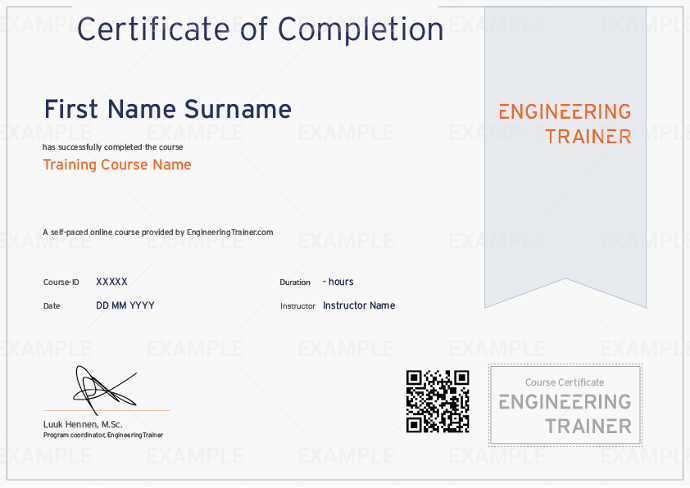
FAQ
This course consists of instructor-led live sessions which consist of presentations, demonstrations and discussions of questions. During each live session participants can ask questions to the instructor (through chat or microphone) which will be answered.
Please note that for privacy reasons no recordings of the live sessions are made or provided.
The training material used in the live sessions, for example the slides or exercises, will be available in the EngineeringTrainer portal for a year after the date of the training allowing you to refresh your knowledge or review material if needed.
No, course content is not available for download.
The training material used in the sessions, for example the slides or exercises, will be available in the EngineeringTrainer portal for a year after the date of the training allowing you to refresh your knowledge or review material if needed.
Please note that for privacy reasons no recordings of the live sessions are made or provided.
Yes, interactive Q&A sessions are part of the live sessions in this course and allow you to interact with the instructor and ask questions.
To respect the privacy of the participants the live sessions will not be recorded, and as such the live sessions cannot be played back. Therefore it is important for all participants to block the time slots of the live sessions in their calendars and be present.
No software licenses are provided as part of this course.
Yes, this course qualifies for PDH hours as per the NCEES CPC Guidelines.
